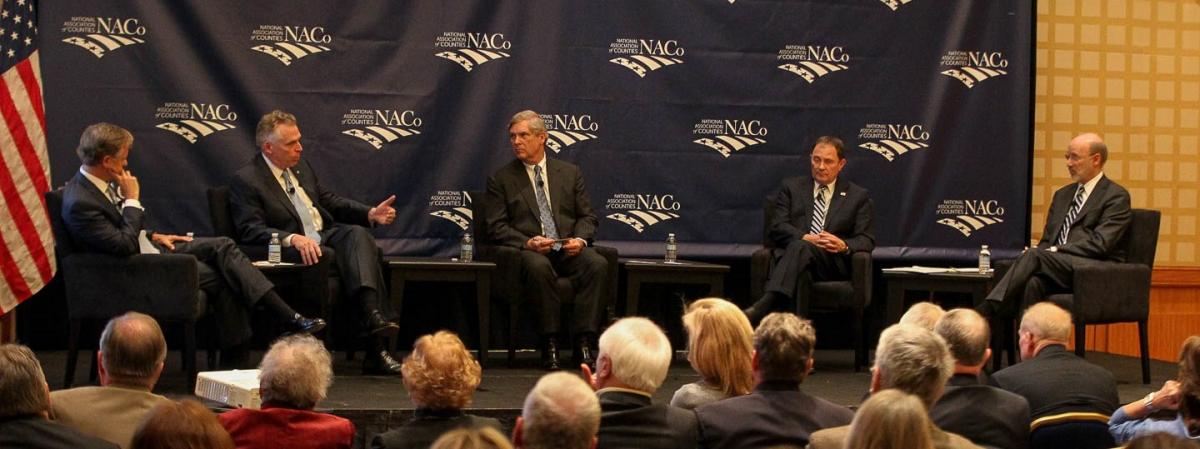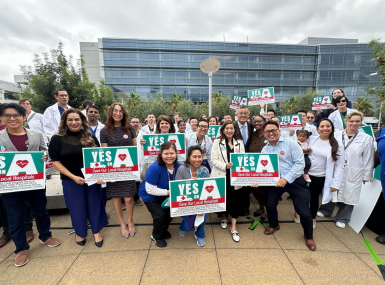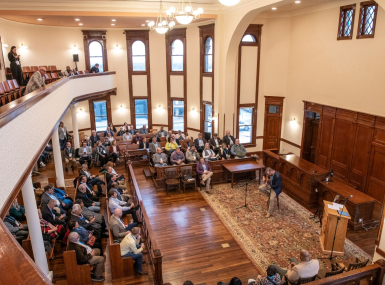NACo 2016 Legislative Conference
Upcoming Events
Related News

U.S. Sen. Mitch McConnell (R-Ky.) addresses the Closing General Session. Photo by David HathcoxWelcome to NACo’s 2016 Legislative Conference
Tuesday, Feb. 23
Senate Majority Leader Mitch McConnell kicked off today's Closing General Session, which also included remarks from Sen. John McCain (R-Ariz.), Transportation Secretary Anthony Foxx, CNN Senior Political Analyst Ron Brownstein and a Washington Post-moderated discussion on rural childhood poverty with Agriculture Secretary Tom Vilsack and Acting Education Secretary John King Jr.
The high profile day also included a Capitol Hill briefing on criminal justice reform, hosted by NACo and featuring Sen John Cornyn (R-Texas) and a Rural Poverty Summit, co-sponsored with the White House Rural Council.
Senate Majority Leader Mitch McConnell
While President Obama may have the constitutional responsibility to nominate a candidate to fill the late Justice Antonin Scalia’s seat on the Supreme Court, it’s the American people, through the next presidential election process, who should decide, according to Senate Majority Leader McConnell.
McConnell, who has already laid down a marker about the Senate’s not considering an Obama nominee, repeated his promise at the Closing General Session. “Let the people decide. The Senate will not be filling that vacancy this year,” he said.
But he also promised that despite election year politics, the Senate will make progress this year, especially in the areas of criminal justice reform and helping in the battle against substance abuse.
As Kentucky’s longest serving senator, McConnell got his political start in county government when he served as judge-executive of Jefferson County, Ky.
Anthony Foxx
U.S. Secretary of Transportation Anthony Foxx announced $500 million in TIGER grants while addressing the Closing General Session.
The competitive grants go to projects that increase access to transportation and generate economic development, and applications are due April 29.
“We need to identify ways to make out system smarter, make our system more well integrated so that the assets and the facilities we have today can punch above their weight,” he said.
Foxx, formerly mayor of Charlotte, thanked NACo members for their work in lobbying members of Congress in support of what became the FAST Act, a five-year $305 billion surface transportation bill, which also included provisions for speeding up permitting for construction projects.
“I don’t think we’d have had a bill passed last year had it not been for the vigorous advocacy of your members,” he said. “It helps to have folks all around the country talking to their business community and their members of Congress.
“While the bill is not perfect...it serves as a bit of a down payment on what our system needs.”
What the transportation system needs will be dictated by population growth and economic shifts, both of which are examined in Beyond Traffic, a comprehensive study of the domestic transportation system now in the draft stage.
With the projected population growth of 70 million over the next 30 years, a corresponding 45 percent increase in freight volume could add 65 more trucks to the road, on top of non-commercial traffic.
Americans drove 3.15 trillion road miles in 2015, 150 billion more than 2014, but Foxx warned that more roads weren’t necessarily the answer.
“We can’t just build our way out of this congestion,” he said, touting the Smart City Challenge
Senator John McCain
The nation’s armed forces were a major focus of Senator McCain’s remarks to conference attendees. He chairs the Senate Armed Services Committee. But he also touched on issues related to the environment, immigration and the overuse of executive privilege by the White House.
He acknowledged improvements in the Department of Veterans Affairs since a scandal rocked his state some years ago, where 50 veterans awaiting treatment at the Phoenix VA hospital died while on a “waiting list” that did not exist.
“It’s hard turning this giant bureaucracy around,” McCain said of the VA, “and I’m proud of Republicans and Democrats working together on this challenge that we all have.”
He advocated for further changes in the healthcare system for veterans — in particular — universal availability of a Choice Card that allows veterans to seek treatment from the provider of their choice. Currently, this option is only available to certain ex-military.
The VA provides the best care possible for traumatic brain injury, PTSD and prostheses, he continued, but the Choice Card would make it possible for former service members to receive care in their own communities.
“We have no greater priority than to care for those who have served and sacrificed on our nation’s behalf,” he said, drawing audience applause.
Later, he took questions from the audience on a range of topics.
In response to one, he disdained President Obama’s use of executive orders to subvert the will of Congress. In a nonpartisan spirit, he added, that applies to any president — current or future, regardless of party. To do otherwise, contradicts the system of checks and balances that the nation’s founders intended.
Monday, Feb. 22

Tennessee Gov. Bill Haslam, Virgina Gov. Terry McAuliffe, U.S. Secretary of Agriculture (and former Iowa Gov.) Tom Vilsack, Utah Gov. Gary Herbert and Pennsylvania Gov. Tom Wolf. Photo by David Hathcox
The conference officially opened today with Chris Wallace, Fox News Sunday host, headlining the Opening General Session, which also featured Dr. France Cordova, director of the National Science Foundation, and White House Drug Policy Director Michael Botticelli.
Book ending the day was a special Governors’ Roundtable Discussion focusing on rural childhood poverty. U.S. Department of Agriculture Secretary Tom Vilsack moderated the panel, which featured Govs. Bill Haslam (Tenn.); Terry McAuliffe (Va.); Gary Herbert (Utah), chair of the National Governors Association; and Tom Wolfe (Pa.). NACo and the White House Rural Poverty Council, sponsored the discussion.
Top level policy briefings continued with HUD Secretary Julian Castro’s appearance at the Large Urban County Caucus meeting and several Administration officials from the Departments of State, Health and Human Services, and Homeland Security discussing refugee and resettlement programs at the Immigration Task Force meeting.
Several workshop blocks were scheduled during the day presenting educational sessions on topics as wide ranging as conducting elections in an era of cyber threats to impacting federal rule making and new government accounting standards.
The Board of Directors also adopted more than 30 new interim policy resolutions at its meeting today, and NACo premier member, Thomson Reuters was presented with NACo’s Award for Corporate Excellence.
Chris Wallace
If Fox News Sunday host Chris Wallace ever quits his day job, he might have a future in stand-up comedy. He warmed up the Opening General Session audience with punchline after punchline before delving into the serious business of the current political landscape.
Wallace analyzed the field of presidential candidates’ chances of winning their party’s nomination. As has been the case throughout the primary season, Donald Trump’s name was mentioned often, both for the unlikeliness of his rise and concerns about his temperament.
Trump has a real shot at being the GOP nominee, Wallace said, but to grow his support, Trump is “going to have to stop making enemies he doesn’t need to make and ... build his coalition bigger than it is.”
As for the Democrats, Wallace said entrance polling of voters in Nevada’s Democrat caucus found Hillary Clinton with the most support from women and elderly voters, but Sanders was favored by more Hispanics. The Vermont senator’s biggest challenge, Wallace said, will be attracting black voters.
That shouldn’t be a problem for Clinton, who with her husband, has had “a 25-year relationship with African Americans.” This should stand her in good stead in South Carolina and other states that have large populations of black voters.
For all of the candidates, the trek to the nomination will be less about “retail” politics and more about “wholesale” from here on out, he said.
“Now it’s going to be fly and buy…. Nobody has the kind of ground game that they had earlier, so a lot of it is going to be wholesale politics where you go in, you hold a mass rally…and then you have to fly off to the next states,” he explained.
In this election year, neither Congress nor the president expect to get much accomplished, Wallace said, but there is some bipartisan agreement around criminal justice reform. For that reason, it has the best — if not only — chance of moving forward.
Keeping Counties Moving: Understanding the Role of Freight Transportation as an Economic Engine
John Vickerman, president of port design firm Vickerman Associates, described the global freight environment and the trends that have driven it for centuries.
Transoceanic freight, in particular, stands out because the vast majority of consumer goods are shipped.
“Cargo will flow down river to the lowest cost, best service levels,” he said, noting that a one-day difference in delivery time was enough to make a shipper rethink things.
Improvements to the Panema and Suez canals has shippers calculating whether to head east or west, but at the same time, the majority of consumer good production is moving west along southeast Asia from China, where it once was. Still, six of the 10 busiest ports in the world remain on the Chinese mainland, with three others elsewhere in Asia.
Capacity is also an issue, though, and as freight ships get larger, they need deeper ports, and the lack of deep water ports in North America is contributing to a competitive disadvantage
“We have 386 public port authorities in North America, but ocean carriers do not consider us a best option,” Vickerman said.
What shippers want in western or Gulf ports, is two-day transit by land to Chicago and three-day transit to New York and New Jersey.
“Seemless access makes all the difference in the world,” he said.
Steve Cernak, director of Port Everglades in Broward County, which handles domestic and international cargo and can connect to 70 percent of the U.S. population within two days.
“Our industry requires consistent reinvestment,” he said. “We have 1.6 billion capital that we’ll be reinvesting over 20 years, but we have to use public private partnerships, we have to diversify our funding.”
Commissioner Brittany Pittman described how Murray County,Ga. used an inland port to revive a stagnant rural economy.
“We had rail, a manufacturing workforce and an excellent U.S. highway system to help,” she said. “All were underutilized resources.”
The port will load shipping trailers carried by truck onto trails that will make a nearly-400-mile trip to Georgia’s port north of Savannah.
LUCC Steering Committee
HUD Secretary Julian Castro updated the LUCC Steering Committee on his department’s initiatives to improve the quality and access to public housing.
“When a person chooses a home, they’re really choosing much more than that,” he said. “They’re choosing their job opportunities, they’re choosing their children’s schools, their access to food in that neighborhood. When folks are discriminated against when looking for a home they’re also denied a fair chance to succeed in life.”
The department published fair housing guidelines at the end of 2015 and released an assessment tool for local governments to use in preparing their fair housing assessments.
In response to less than one-third of community development block grant funding being spent on actual housing, rather than infrastructure projects, HUD is working with mayors, county executives and city council leaders to design plans to use federal resources in a “more focused way.”
He called on county leaders to commit to ending homelessness, and offered a tip.
“The most successful approach to addressing chronic homelessness involves putting individuals and families directly into affordable units,” he said, noting that 21 communities and two states have effectively ended veteran homelessness.
Castro stressed the importance of connecting public housing residents, children particularly, to the Internet.
He touted HUD’s measures to improve options for people with criminal records. Those include connecting them to reentry services, barring landlords from using arrest records to keep someone from renting a home, and ending the one-strike policy for drug offenses and offenders’ families that would disqualify them from public housing.
A Special Governors' Roundtable: State and County Collaboration to Tackle Chronic Rural Poverty
Four governors discussed steps their administrations are taking to alleviate poverty in their states’ rural areas, where poverty is often concentrated. The answer was elementary, elementary education and earlier.
“We did a survey, asking of all the jobs that will exist 10 years from now, what will they look like,” said Tennessee Gov. Bill Haslam (R), now in his second term. “We found that 55 percent will require some kind of certificate beyond high school. In our rural areas, we have about 15-20 percent, so it made that challenge really acute.”
Haslam’s answer was the Tennessee Promise: two years of free community college or technical school education to anyone who graduates from high school
Virginia Gov. Terry McAuliffe (D) reflected on what economic downturns and subsequent migration could mean for the economic viability of the southern parts of his state.
“Coal, tobacco, textile, furniture... they have all been decimated and what is left are probably the most honest, hardworking folk you have ever met in your life,” he said. ”But I have zero chance of bringing a business to a community if they don’t think they’ll have a workforce, 20 or 30 years from today. You need a workforce, and that workforce starts with education, with pre-K.”
And what’s just as important as what they learn is the condition in which they try to learn, so McAuliffe is working to provide universal breakfast to all students by the end of his term-limited four years in office.
Both McAuliffe and Haslam convene “children’s cabinets,” representatives from departments that enact policy that affects children.
Utah Gary Herbert (R) stressed the natural support systems that comes with the family unit, provided it’s done in the right way.
“We teach our children in schools, if you want to avoid poverty, here are four steps: get a good education...get a job...get married...have children, and do them in that order,” he said. “You’ll have a better chance at staying out of poverty than people who do them out of order.”
First-term Pennsylvania Gov. Tom Wolf (D) sees a lot of his state’s rural population facing a crisis of intergenerational transfer of farm assets.
“We’re a mid-Atlantic state, but agriculture is our biggest industry,” he said. “We have to make sure the younger generation wants to stay where they grew up and take over the family farm.”
But those rural communities need more than just farms to be attractive, and sparse population makes it hard to reach critical mass for development. Regardless, Wolf has made education funding a centerpiece of his administration, enough so that his budget request to raise education funding has led to an eight-month budget impasse with the Legislature.
Sunday, Feb. 21
Sunday is another busy meeting day. More than 30 meetings were scheduled during the day, several punctuated with presentations intended to inform policy discussions.
Community, Economic and Workforce Development Steering Committee
The joint meeting of NACo workforce and economic development subcommittees was an educational session on attracting foreign investment to counties. Topics ranged from the Export-Import (Ex-Im) Bank of the United States to the EB-5 visa program — and how counties can avail themselves of their resources.
Speakers included Fred Hochberg, chairman and president of the Ex-Im bank and representatives of SelectUSA and Invest in the USA (IIUSA).
David Campbell is deputy director of investment services for SelectUSA, an offshoot of the U.S. Commerce Department.
He said his agency can help U.S territories, states and counties to “think critically about what it means to attract foreign direct investment.”
“We believe the data is very compelling and clear that foreign direct investment is a net boost for the U.S. economy overall and for the local U.S. communities where it occurs,” he said.
Public Lands Steering Committee
When public lands issues got a national media spotlight, it was far from what anyone involved in policymaking would have wanted.
After the 40-day armed occupation of the Malheur National Wildlife Refuge in Oregon ended, Harney County Judge Steven Grasty explained that without the intimidation factor, the occupation of the refuge would have been completely different. The presence of firearms in both the tower on the refuge and out and about in town muddled the issue of federal land ownership in a rural county to a wide audience.
“You don’t put guys in a tower with long ranged weapons and not call it in armed takeover,” he said. “(Ammon Bundy) saw a welcoming community and saw it as support (for his cause)...and you had armed men from this group guarding the Safeway. That’s intimidation.”
Grasty pointed out that outsiders made up most of the force, noting he picked out 25 familiar faces in a protest of more than 300, but it was an impetus to encouraged elected officials to keep a closer look on what is going on in their counties.
“Do you really know your community?” he asked. “Are there groups you aren’t talking to? If someone starts up a committee of safety, you have to be very attentive to that.”
He did find a silver lining: a boom in attendance at County Court meetings.
“We usually we have 4-5 people in the meetings, now we have 35,” he said.
U.S. Forest Service Chief Thomas Tidwell said his department was running smoother and more efficient than ever before.
The big figure: the forest service’s timber harvest has reached its 1998 level, despite cutting more than one-third of its staff. And, of its 328 decisions in 2015, only 10 were challenged in court.
How is that happening?
“We’re doing a better job bringing everybody together, providing the time so that everybody has a chance to contribute, and reach an agreement without going to court,” he said. “Once you start to build that trust, the next time it gets a little easier, a little faster, and you’re able to take on much larger projects that really make a difference.”
Regarding President Obama’s 2017 budget proposal, “I have to feel fortunate that the budget is flat,” he said. “The only place there’s significant increase is fire suppression.”
The research and development budget has been cut, to Tidwell’s chagrin, because wood has a future as a green building material, as demonstrated by the construction of a wooden highrise in Portland, Ore.
At the same time, he doesn’t want commercial interests driving forest policy.
“We have to change this perception that we’re cutting trees for somebody to make money versus we’re harvesting timber to maintain our forests,” he said. “Without management, the science is so clear, were going to continue to lose the productivity of our forests.”
Bureau of Land Management Director Neil Kornze explained the bureau’s revisions to resource management plans (RPM). Dubbed “Planning 2.0,” it aims to increase public participation in the planning process and ensure the most up-to-date data is used.
“It has taken us 8-10 years to complete some RPMs and cost $1 million a year,” he said. “It’s too slow, people have a hard time tracking their comments and if they have any influence in the process.”
One immediate change is a small-scale release of planning options before they are developed to draft form.
“It’s a halfway step,” Kornze said. “We come back to public have them give us a gut check, if these options we lay out and our justification are reasonable. There will be instances where we have to start over, but doing that later on kills the public participation. And new information comes to us later on.”
He touted the development of solar power facilities on BLM land, all of which have begun in the last seven years, as “providing an onramp for a lot of rural communities to get into the energy game.”
The joint meeting of NACo workforce and economic development subcommittees was an educational session on attracting foreign investment to counties. Topics ranged from the Export-Import (Ex-Im) Bank of the United States to the EB-5 visa program — and how counties can avail themselves of their resources.
Speakers included Fred Hochberg, chairman and president of the Ex-Im bank and representatives of SelectUSA and Invest in the USA (IIUSA).
Breakfast Roundtable: The Economic Impact of Aging on Counties
Convened by the Healthy Counties Counties Board and the Health Policy and Human Services and Education steering committees, the roundtable featured expert discussions about the challenges counties will encounter as the baby boom generation continues to age.
Already at 14 percent of the population, those aged 65 or older are expected to double by 2050.
The older population is increasingly reliant on Social Security benefits as their sole source of financial support, according to Dr. Peter Arno, senior fellow and director of health policy research, University of Massachusetts Amherst’s Political Economy Research Institute.
Arno’s Regional Social Security Support Index, which measures the dependency of the older population on social security at both the state and county levels, shows lots of diversity among and within the states North Dakota, for example -- which was the only state to reduce its dependency on social security benefits -- still has pockets of counties where dependency remains high. Despite North Dakota’s shift, overall, the index shows that dependency has shifted dramatically since 2008.
“Social security plays an incredibly important role for income support and poverty reduction.”
Arno pointed to research that shows how social security benefits cycle through the economy, providing important economic benefits in communities.
He believes social security is very stable. He said as much in answer to a question about the fund’s long term prospects.
“Social security is extraordinarily well-financed despite what you hear in the media,” he said. It’s 100 percent solid through 2034. After then, estimates project 20 to 25 percent reductions, but that's very unlikely. “It's never been allowed to happen before,” he said.
What changes does he see in the future as the aging population continues to grow? More resources will need to be directed towards the aging population and developing an infrastructure in communities to support its aging members.
He was asked how to improve social security’s solvency. “Lift the cap on earnings like was done with the Medicare tax in the mid 1980s. “That would solve 80-90 percent of the solvency issues.”
The most repeated take away from the discussion about health care for the aging population: health happens outside of acute care facilities. Chronic conditions must be managed; transportation must be available for doctors visits; meals provided for recently discharged patients and community infrastructures developed that encourage exercise of both brain and brawn.
Dr. Joseph Agostini, national medical director for Aetna Medicare, suggested several ways to help improve the quality and cost of health care for the Medicare population.
First, insure access to primary care physicians for wellness and prevention services. Think about how to develop liveable and walkable communities for older populations. Next, identify and engage people with chronic conditions to help them manage their conditions better. Encourage coordinated and follow-up care after as people transition from a hospital to a nursing facility to their homes. And finally, he advised making certain there is a palliative care system in the community that stresses care for the whole person as they become closer to dying.
Saturday, Feb. 20
More than 1,600 county officials have begun arriving for the 2016 Legislative Conference. The conference focuses on framing NACo’s legislative policy strategies and brings in thought leaders from both private and public sectors.
Today, White House Deputy Chief Technology Officer DJ Patil was the keynote luncheon speaker at the Technology Innovation Summit.
He has noticed a dramatic cultural transformation.
“Nerds are sexy again,” he said.
The proliferation of data-driven analysis, services and products, and the demand for analytic skills has helped that. And that appreciation goes to the top.
“The president recognizes that data one of those fundamental lever arms that can change the trajectory of policies, progress and all of the things that we do,” he said.
With more and more data sources available to the public, the difference truly is made by who is interpreting and using the data
“If everyone is looking at the data, you can solve problems faster,” Patil said. “When a government agency makes data available, it’s not the general public rushing in to look at it, it’s other departments...It refutes the notion you need someone to come in from Silicon Valley to rescue government. People in government need an opportunity to show what they can do.”
He explained how Miami-Dade County, Fla. was able to use data about its inmates to drive revisions to emergency dispatcher training which, when combined with crisis intervention team implementation, helped divert mentally-ill offenders to treatment, rather than the jail, which has reduced the inmate population enough that the county has closed one of its jails and saved $12 million in a year.
Perseverance, Patil said, was crucial to making data analysis work.
“There’s no company that got data policy right on the first three tries,” he said. In that process “you need a tolerance to know that you’re learning and the discipline to stay with it.”
He stressed the need for a data ethics component to training loads for data scientists. And he predicted the number of entities willing to share data would increase once they could find demonstrable benefit.
“(You’ll) want data to augment your decision making process,” he said. “People don’t have the same fear of data once they see how it’s being used to bring value to you.”
Steering Committees
The U.S. Justice Department (DOJ) will be paying close attention to county courthouses this year for compliance with the Americans with Disabilities, according to Bruce Adelson, CEO of Federal Compliance Consulting and a former Justice Department lawyer.
“The current push for courthouses is to get them up to accessibility long before the November elections,” he said. “This is a relatively new push by Justice concerning courthouses, but I suspect that this will also ramp up as the year goes on.”
Adelson spoke at a Finance, Pensions and Intergovernmental Affairs Steering Committee subcommittee meeting.
Counties should also make sure their websites are ADA-compliant. He quoted a recent law journal article that contends that “ADA litigation over website accessibility is exploding.”
He predicted that DOJ will be developing new rules “no later than this summer that will impact all of your websites.” That, too, has an elections nexus because of the amount of elections-related materials that is now accessed online.
If counties are sued for noncompliance and lose, the consequences could be expensive. Counties could be on the hook for punitive damages and attorney's fees.
Attachments
Related News

California county sales tax measure backfills federal healthcare cuts
Santa Clara County, Calif. will raise an estimated $330 million each year from a sales tax to backfill lose Medicaid funding.

Emotion and perspective help frame stories
A songwriter and a nonfiction author shared their techniques for telling memorable stories at the County Storyteller Symposium in early December.
